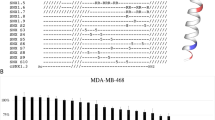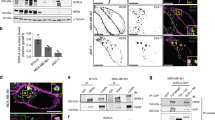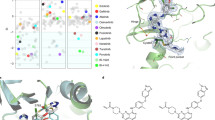Abstract
There is increasing evidence implicating human epidermal growth factor receptor 3 (HER3) in several types of cancer. However, the development of targeted therapies to inactivate HER3 function has been a challenging endeavor. Its kinase domain functions in allostery not catalysis, and the classical ATP-analog class of tyrosine kinase inhibitors fail to inactivate it. Here we describe a novel approach that eliminates HER3 expression. The small-molecule cotransin CT8 binds the Sec61 translocon and prevents the signal peptide of the nascent HER3 protein from initiating its cotranslational translocation, resulting in the degradation of HER3 but not the other HER proteins. CT8 treatment suppresses the induction of HER3 that accompanies lapatinib treatment of HER2-amplified cancers and synergistically enhances the apoptotic effects of lapatinib. The target selectivities of cotransins are highly dependent on their structure and the signal sequence of targeted proteins and can be narrowed through structure–function studies. Targeting Sec61-dependent processing identifies a novel strategy to eliminate HER3 function.
This is a preview of subscription content, access via your institution
Access options
Subscribe to this journal
Receive 50 print issues and online access
$259.00 per year
only $5.18 per issue
Buy this article
- Purchase on Springer Link
- Instant access to full article PDF
Prices may be subject to local taxes which are calculated during checkout





Similar content being viewed by others
References
Licitra L, Mesia R, Rivera F, Remenar E, Hitt R, Erfan J et al. Evaluation of EGFR gene copy number as a predictive biomarker for the efficacy of cetuximab in combination with chemotherapy in the first-line treatment of recurrent and/or metastatic squamous cell carcinoma of the head and neck: EXTREME study. Ann Oncol 2011; 22: 1078–1087.
Lopez-Gines C, Cerda-Nicolas M, Gil-Benso R, Pellin A, Lopez-Guerrero JA, Callaghan R et al. Association of chromosome 7, chromosome 10 and EGFR gene amplification in glioblastoma multiforme. Clin Neuropathol 2005; 24: 209–218.
Santin AD, Bellone S, Van Stedum S, Bushen W, Palmieri M, Siegel ER et al. Amplification of c-erbB2 oncogene: a major prognostic indicator in uterine serous papillary carcinoma. Cancer 2005; 104: 1391–1397.
Slamon DJ, Clark GM, Wong SG, Levin WJ, Ullrich A, McGuire WL . Human breast cancer: correlation of relapse and survival with amplification of the HER-2/neu oncogene. Science 1987; 235: 177–182.
Yano T, Doi T, Ohtsu A, Boku N, Hashizume K, Nakanishi M et al. Comparison of HER2 gene amplification assessed by fluorescence in situ hybridization and HER2 protein expression assessed by immunohistochemistry in gastric cancer. Oncol Rep 2006; 15: 65–71.
Frederick L, Wang XY, Eley G, James CD . Diversity and frequency of epidermal growth factor receptor mutations in human glioblastomas. Cancer Res 2000; 60: 1383–1387.
Sharma SV, Bell DW, Settleman J, Haber DA . Epidermal growth factor receptor mutations in lung cancer. Nat Rev Cancer 2007; 7: 169–181.
Bose R, Kavuri SM, Searleman AC, Shen W, Shen D, Koboldt DC et al. Activating HER2 mutations in HER2 gene amplification negative breast cancer. Cancer Discov 2013; 3: 224–237.
Shigematsu H, Takahashi T, Nomura M, Majmudar K, Suzuki M, Lee H et al. Somatic mutations of the HER2 kinase domain in lung adenocarcinomas. Cancer research 2005; 65: 1642–1646.
Baselga J, Cortes J, Kim SB, Im SA, Hegg R, Im YH et al. Pertuzumab plus trastuzumab plus docetaxel for metastatic breast cancer. N Engl J Med 2012; 366: 109–119.
Geyer CE, Forster J, Lindquist D, Chan S, Romieu CG, Pienkowski T et al. Lapatinib plus capecitabine for HER2-positive advanced breast cancer. N Engl J Med 2006; 355: 2733–2743.
Lynch TJ, Bell DW, Sordella R, Gurubhagavatula S, Okimoto RA, Brannigan BW et al. Activating mutations in the epidermal growth factor receptor underlying responsiveness of non-small-cell lung cancer to gefitinib. N Engl J Med 2004; 350: 2129–2139.
Slamon DJ, Leyland-Jones B, Shak S, Fuchs H, Paton V, Bajamonde A et al. Use of chemotherapy plus a monoclonal antibody against HER2 for metastatic breast cancer that overexpresses HER2. N Engl J Med 2001; 344: 783–792.
Holbro T, Beerli RR, Maurer F, Koziczak M, Barbas CF 3rd, Hynes NE . The ErbB2/ErbB3 heterodimer functions as an oncogenic unit: ErbB2 requires ErbB3 to drive breast tumor cell proliferation. Proc Natl Acad Sci USA 2003; 100: 8933–8938.
Lee-Hoeflich ST, Crocker L, Yao E, Pham T, Munroe X, Hoeflich KP et al. A central role for HER3 in HER2-amplified breast cancer: implications for targeted therapy. Cancer Res 2008; 68: 5878–5887.
Vaught DB, Stanford JC, Young C, Hicks DJ, Wheeler F, Rinehart C et al. HER3 is required for HER2-induced preneoplastic changes to the breast epithelium and tumor formation. Cancer Res 2012; 72: 2672–2682.
Jura N, Shan Y, Cao X, Shaw DE, Kuriyan J . Structural analysis of the catalytically inactive kinase domain of the human HER3 receptor. Proc Nat Acad Sci USA 2009; 106: 21608–21613.
Prigent SA, Gullick WJ . Identification of c-erbB-3 binding sites for phosphatidylinositol 3'-kinase and SHC using an EGF receptor/c-erbB-3 chimera. EMBO J 1994; 13: 2831–2841.
Soltoff SP, Carraway KL 3rd, Prigent SA, Gullick WG, Cantley LC . ErbB3 is involved in activation of phosphatidylinositol 3-kinase by epidermal growth factor. Mol Cell Biol 1994; 14: 3550–3558.
Amin DN, Sergina N, Ahuja D, McMahon M, Blair JA, Wang D et al. Resiliency and vulnerability in the HER2-HER3 tumorigenic driver. Sci Transl Med 2010; 2: 16ra17.
Garrett JT, Olivares MG, Rinehart C, Granja-Ingram ND, Sanchez V, Chakrabarty A et al. Transcriptional and posttranslational up-regulation of HER3 (ErbB3) compensates for inhibition of the HER2 tyrosine kinase. Proc Natl Acad Sci USA 2011; 108: 5021–5026.
Sergina NV, Rausch M, Wang D, Blair J, Hann B, Shokat KM et al. Escape from HER-family tyrosine kinase inhibitor therapy by the kinase-inactive HER3. Nature 2007; 445: 437–441.
Littlefield P, Moasser MM, Jura N . An ATP-competitive inhibitor modulates the allosteric function of the HER3 pseudokinase. Chem Biol 2014; 21: 453–458.
Blackburn E, Zona S, Murphy ML, Brown IR, Chan SK, Gullick WJ . A monoclonal antibody to the human HER3 receptor inhibits Neuregulin 1-beta binding and co-operates with Herceptin in inhibiting the growth of breast cancer derived cell lines. Breast Cancer Res Treat 2012; 134: 53–59.
Foreman PK, Gore M, Kobel PA, Xu L, Yee H, Hannum C et al. ErbB3 inhibitory surrobodies inhibit tumor cell proliferation in vitro and in vivo. Mol Cancer Ther 2012; 11: 1411–1420.
Garner AP, Bialucha CU, Sprague ER, Garrett JT, Sheng Q, Li S et al. An antibody that locks HER3 in the inactive conformation inhibits tumor growth driven by HER2 or neuregulin. Cancer Res 2013; 73: 6024–6035.
Kugel CH III, Hartsough EJ, Davies MA, Setiady YY, Aplin AE . Function-blocking ERBB3 antibody inhibits the adaptive response to RAF inhibitor. Cancer Res 2014; 74: 4122–4132.
McDonagh CF, Huhalov A, Harms BD, Adams S, Paragas V, Oyama S et al. Antitumor activity of a novel bispecific antibody that targets the ErbB2/ErbB3 oncogenic unit and inhibits heregulin-induced activation of ErbB3. Mol Cancer Ther 2012; 11: 582–593.
Schoeberl B, Faber AC, Li D, Liang MC, Crosby K, Onsum M et al. An ErbB3 antibody, MM-121, is active in cancers with ligand-dependent activation. Cancer Res 2010; 70: 2485–2494.
Garrison JL, Kunkel EJ, Hegde RS, Taunton J . A substrate-specific inhibitor of protein translocation into the endoplasmic reticulum. Nature 2005; 436: 285–289.
Maifeld SV, MacKinnon AL, Garrison JL, Sharma A, Kunkel EJ, Hegde RS et al. Secretory protein profiling reveals TNF-alpha inactivation by selective and promiscuous Sec61 modulators. Chem Biol 2011; 18: 1082–1088.
Gerbin CS, Landgraf R . Geldanamycin selectively targets the nascent form of ERBB3 for degradation. Cell Stress Chaperones 2010; 15: 529–544.
Mackinnon AL, Paavilainen VO, Sharma A, Hegde RS, Taunton J . An allosteric Sec61 inhibitor traps nascent transmembrane helices at the lateral gate. eLife 2014; 3: e01483.
Harant H, Lettner N, Hofer L, Oberhauser B, de Vries JE, Lindley IJ . The translocation inhibitor CAM741 interferes with vascular cell adhesion molecule 1 signal peptide insertion at the translocon. J Biol Chem 2006; 281: 30492–30502.
Tao JJ, Castel P, Radosevic-Robin N, Elkabets M, Auricchio N, Aceto N et al. Antagonism of EGFR and HER3 enhances the response to inhibitors of the PI3K-Akt pathway in triple-negative breast cancer. Sci Signal 2014; 7: ra29.
Sheng Q, Liu X, Fleming E, Yuan K, Piao H, Chen J et al. An activated ErbB3/NRG1 autocrine loop supports in vivo proliferation in ovarian cancer cells. Cancer Cell 2010; 17: 298–310.
Beji A, Horst D, Engel J, Kirchner T, Ullrich A . Toward the prognostic significance and therapeutic potential of HER3 receptor tyrosine kinase in human colon cancer. Clin Cancer Res 2012; 18: 956–968.
Gespach C . Increasing potential of HER3 signaling in colon cancer progression and therapy. Clin Cancer Res 2012; 18: 917–919.
Yao YL, Shao J, Zhang C, Wu JH, Zhang QH, Wang JJ et al. Proliferation of colorectal cancer is promoted by two signaling transduction expression patterns: ErbB2/ErbB3/AKT and MET/ErbB3/MAPK. PLoS ONE 2013; 8: e78086.
Sun C, Hobor S, Bertotti A, Zecchin D, Huang S, Galimi F et al. Intrinsic resistance to MEK inhibition in KRAS mutant lung and colon cancer through transcriptional induction of ERBB3. Cell Rep 2014; 7: 86–93.
Zhang L, Castanaro C, Luan B, Yang K, Fan L, Fairhurst JL et al. ERBB3/HER2 signaling promotes resistance to EGFR blockade in head and neck and colorectal cancer models. Mol Cancer Ther 2014; 13: 1345–1355.
Abel EV, Basile KJ, Kugel CH III, Witkiewicz AK, Le K, Amaravadi RK et al. Melanoma adapts to RAF/MEK inhibitors through FOXD3-mediated upregulation of ERBB3. J Clin Invest 2013; 123: 2155–2168.
Fattore L, Marra E, Pisanu ME, Noto A, de Vitis C, Belleudi F et al. Activation of an early feedback survival loop involving phospho-ErbB3 is a general response of melanoma cells to RAF/MEK inhibition and is abrogated by anti-ErbB3 antibodies. J Transl Med 2013; 11: 180.
Reschke M, Mihic-Probst D, van der Horst EH, Knyazev P, Wild PJ, Hutterer M et al. HER3 is a determinant for poor prognosis in melanoma. Clin Cancer Res 2008; 14: 5188–5197.
Amin DN, Sergina N, Lim L, Goga A, Moasser MM . HER3 signalling is regulated through a multitude of redundant mechanisms in HER2-driven tumour cells. Biochem J 2012; 447: 417–425.
Besemer J, Harant H, Wang S, Oberhauser B, Marquardt K, Foster CA et al. Selective inhibition of cotranslational translocation of vascular cell adhesion molecule 1. Nature 2005; 436: 290–293.
Lee H, Maihle NJ . Isolation and characterization of four alternate c-erbB3 transcripts expressed in ovarian carcinoma-derived cell lines and normal human tissues. Oncogene 1998; 16: 3243–3252.
Lee H, Akita RW, Sliwkowski MX, Maihle NJ . A naturally occurring secreted human ErbB3 receptor isoform inhibits heregulin-stimulated activation of ErbB2, ErbB3, and ErbB4. Cancer Res 2001; 61: 4467–4473.
Chen Y, Bilban M, Foster CA, Boger DL . Solution-phase parallel synthesis of a pharmacophore library of HUN-7293 analogues: a general chemical mutagenesis approach to defining structure–function properties of naturally occurring cyclic (depsi)peptides. J Am Chem Soc 2002; 124: 5431–5440.
MacKinnon AL, Garrison JL, Hegde RS, Taunton J . Photo-leucine incorporation reveals the target of a cyclodepsipeptide inhibitor of cotranslational translocation. J Am Chem Soc 2007; 129: 14560–14561.
Giaretti W, Nusse M . Light scatter of isolated cell nuclei as a parameter discriminating the cell-cycle subcompartments. Methods Cell Biol 1994; 41: 389–400.
Hulleman JD, Brown SJ, Rosen H, Kelly JW . A high-throughput cell-based Gaussia luciferase reporter assay for identifying modulators of fibulin-3 secretion. J Biomol Screen 2013; 18: 647–658.
Acknowledgements
This work was supported by the National Institutes of Health CA122216 and CA112970 (to MMM), Howard Hughes Medical Institute (to JT) and a Fundación Ramón Areces Fellowship (to ARS).
Author information
Authors and Affiliations
Corresponding author
Ethics declarations
Competing interests
The authors declare no conflict of interest.
Additional information
Supplementary Information accompanies this paper on the Oncogene website
Supplementary information
Rights and permissions
About this article
Cite this article
Ruiz-Saenz, A., Sandhu, M., Carrasco, Y. et al. Targeting HER3 by interfering with its Sec61-mediated cotranslational insertion into the endoplasmic reticulum. Oncogene 34, 5288–5294 (2015). https://doi.org/10.1038/onc.2014.455
Received:
Revised:
Accepted:
Published:
Issue Date:
DOI: https://doi.org/10.1038/onc.2014.455
This article is cited by
-
The role of HER2 and HER3 in HER2-amplified cancers beyond breast cancers
Scientific Reports (2021)
-
Prospects for pharmacological targeting of pseudokinases
Nature Reviews Drug Discovery (2019)
-
Inhibitors of protein translocation across membranes of the secretory pathway: novel antimicrobial and anticancer agents
Cellular and Molecular Life Sciences (2018)



